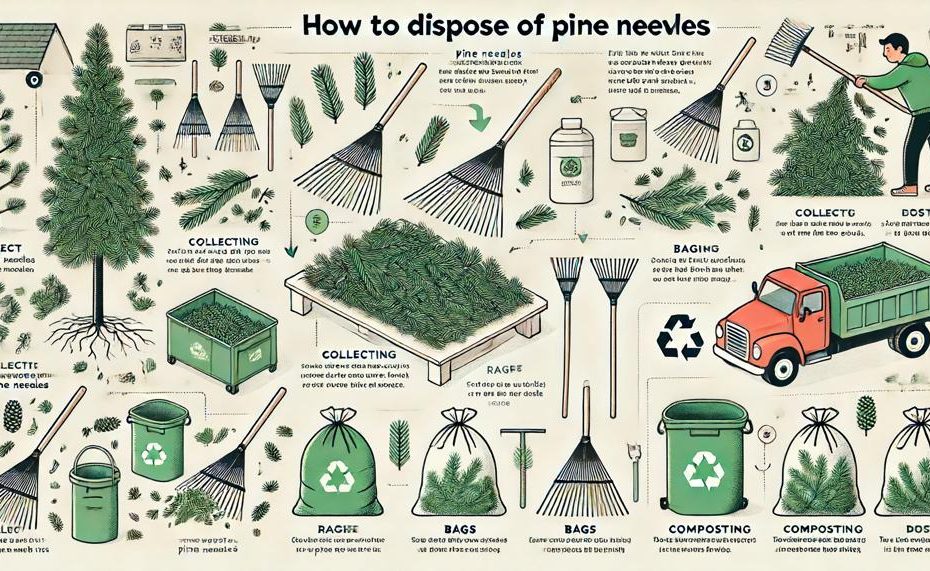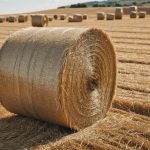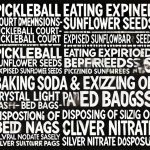Pine needles, those prickly reminders of fall and winter, can be more than just a seasonal nuisance. Properly disposing of these needles not only helps keep your yard tidy but also benefits the environment. Here’s a quick guide to make the process easier:
- Composting: A top choice for many, composting pine needles helps them break down into nutrient-rich soil in about three months. This method is eco-friendly and practical for gardeners.
- Green Waste Disposal Sites: If you prefer not to compost at home, these sites are an excellent alternative for disposing of large amounts of pine needles.
- Mulching: Spread dried pine needles in garden beds to retain soil moisture and suppress weeds. It’s a great way to recycle and enhance your garden.
- Burning: Though effective, burning pine needles requires caution due to safety and environmental concerns. Always check local regulations before choosing this method.
- Collection Methods: Efficiently gather pine needles using a leaf blower and tarp or the classic push-broom and shovel technique. Store collected needles in containers until disposal.
By choosing the right method, you can turn the chore of pine needle disposal into a beneficial practice for your home and garden.
Contents
- 1 Understanding the Basics of Pine Needle Composting
- 2 The Benefits of Composting Pine Needles
- 3 Preparing Pine Needles for Composting
- 4 The Composting Process
- 5 Tips for Successful Pine Needle Composting
- 6 Addressing Concerns About Pine Needle Composting
- 7 Busting Common Myths About Pine Needle Composting
- 8 Conclusion
Understanding the Basics of Pine Needle Composting
The process of composting pine needles involves several key steps:
Collection and Preparation:
- Collect Pine Needles: Gather pine needles using tools like a leaf blower, rake, or shovel.
- Remove Non-Biodegradable Materials: Ensure that sticks, stones, and plastic debris are removed from the collected pine needles.
- Chop or Shred Pine Needles: Cut or shred the needles into smaller pieces to speed up the decomposition process.
Creating the Compost Pile:
- Layering: Place a layer of pine needles at the bottom of the compost bin or pile.
- Balancing Carbon and Nitrogen: Mix pine needles with nitrogen-rich materials (like grass clippings or kitchen scraps) to achieve a balanced carbon to nitrogen ratio of about 30:1.
- Maintaining Oxygen Levels: Turn the pile regularly to maintain oxygen levels, which are crucial for microbial activity.
- Monitoring Moisture: Keep the pile moist but not waterlogged. Aim for the moisture level of a wrung-out sponge.
Decomposition:
- Hot Composting: For faster results, use a hot composting method by ensuring the pile reaches temperatures between 54-65°C (130-150°F). This accelerates the breakdown of pine needles.
- Time: Under ideal conditions, pine needles will decompose in less than a year. Regular turning and proper balance of materials will ensure efficient composting.
The Benefits of Composting Pine Needles
The environmental benefits of composting pine needles are numerous and impactful. Here’s a detailed breakdown:
- Nutrient Recycling: Composting pine needles turns organic waste into nutrient-rich compost, which improves soil health and promotes plant growth without the need for chemical fertilizers. This recycling process helps maintain a sustainable garden ecosystem.
- Soil Improvement: Pine needles, once composted, enhance soil structure, increasing its ability to retain moisture and improving aeration. This leads to healthier root systems and stronger plants.
- Reduction of Waste: By composting pine needles instead of disposing of them, we reduce the amount of organic waste sent to landfills. This minimises methane emissions from decomposing organic matter in landfills, contributing to lower greenhouse gas levels.
- Carbon Sequestration: Pine needles are rich in carbon. Composting them helps store carbon in the soil, reducing the amount of CO2 in the atmosphere, which is beneficial for mitigating climate change.
- Water Conservation: The organic matter from composted pine needles improves the soil’s water retention capacity, reducing the need for frequent watering and conserving water resources.
- Erosion Control: When used as compost or mulch, pine needles help prevent soil erosion by providing a protective layer that absorbs rainfall impact and reduces runoff.
Preparing Pine Needles for Composting
Preparing pine needles for composting involves several steps to ensure they break down efficiently and contribute beneficially to your compost. Here’s a detailed guide:
| Step | Action | Details |
| Gather Pine Needles | Collect fresh needles | Ensure they are free of contaminants |
| Shred or Chop | Break needles into smaller pieces | Increases surface area for decomposition |
| Mix with Organics | Combine with other materials | Include fruit/vegetable scraps, grass, leaves |
| Moisten Mixture | Add water | Keep moist, not waterlogged |
| Turn Regularly | Aerate the compost | Turn to speed up decomposition |
| Monitor | Check temperature and moisture | Ideal temp: 135-160°F (57-71°C) |
| Decompose | Allow time to compost | Several months, typically 6 months to a year |
The Composting Process
The short answer is yes, pine needles can be composted and used as a natural fertilizer for gardening. However, it’s important to follow certain steps to ensure they break down effectively and contribute beneficially to your garden.
To compost pine needles and use them as a natural fertilizer, follow these detailed steps:
Gathering and Shredding:
Collect fresh or aged pine needles from your yard.
Shred them to increase their surface area, which speeds up decomposition.
Mixing with Green Materials:
Mix pine needles with green materials like grass clippings, vegetable scraps, and coffee grounds. This balances the carbon-to-nitrogen ratio essential for composting.
Ensure pine needles constitute only about 10% of the compost heap to avoid slowing down the process.
Layering:
Create alternating layers of shredded pine needles and green materials in your compost bin or pile.
This layering helps maintain proper aeration and encourages microbial activity.
Moisture and Aeration:
Keep the compost pile moist but not waterlogged. A damp sponge consistency is ideal.
Turn the pile every few weeks to introduce oxygen, which is crucial for aerobic decomposition.
Monitoring:
Monitor the temperature of the compost pile. An active compost heap should heat up to between 55-65°C (130-150°F).
If the pile cools down, turning it can help reheat and continue the composting process.
Timeframe:
Fresh pine needles take about 5-6 weeks to compost, while aged ones take roughly 3 weeks.
Ensure the compost is fully decomposed before using it in your garden to prevent any potential issues with acidity.
Using Pine Needle Compost as Fertilizer
Once your pine needles have fully composted, they can be used as a natural fertilizer for your garden:
- Soil Amendment:
- Mix the compost into the soil to improve its structure, increase nutrient content, and enhance water retention.
- Mulch:
- Spread the composted pine needles around plants as mulch. This helps conserve moisture, suppress weeds, and gradually release nutrients into the soil.
Tips for Successful Pine Needle Composting
Composting pine needles can yield rich, nutrient-dense soil for your garden. Here are some essential tips to make the process effective:
Prepare Your Compost Pile
- Choose a sunny location for your compost pile.
- Mix pine needles with other organic materials to balance the compost.
Chop or Shred Pine Needles
- Shredding or chopping pine needles speeds up decomposition.
- Use a mulcher or lawn mower for this task.
Mix with Green Materials
- Combine pine needles (brown material) with green materials (kitchen scraps, grass clippings).
- Aim for a 3:1 ratio of brown to green materials to maintain a healthy compost.
Maintain Moisture Levels
- Keep the compost pile moist, but not soggy.
- Water the pile as needed to ensure it remains damp.
Turn the Pile Regularly
- Turn the compost pile every few weeks to aerate and speed up decomposition.
- This helps to distribute moisture and heat evenly.
Monitor pH Levels
- Contrary to popular belief, pine needles are not highly acidic once decomposed.
- Use a pH testing kit to ensure balanced acidity in your compost.
Avoid Treated Pine Needles
- Do not use pine needles that have been treated with pesticides or other chemicals.
- These can harm your compost and plants.
Be Patient
- Pine needles decompose slowly, often taking several months.
- The wait is worth it for the nutrient-rich compost they produce.

Addressing Concerns About Pine Needle Composting
Composting pine needles presents several common concerns that gardeners may encounter. These concerns include their slow decomposition rate, potential acidity, and the need for careful balancing within the compost mix. Here’s a detailed look at these concerns and practical solutions:
| Concern | Explanation | Solution |
| Slow Decomposition | Pine needles decompose slowly due to their tough, waxy coating and high lignin content, which can delay compost production. | Shred pine needles into smaller pieces and mix them with other organic materials like kitchen scraps or green garden waste to accelerate decomposition. Regularly turning the compost pile can also help increase the rate of breakdown. |
| Acidity Concerns | Fresh pine needles are acidic, which can lower the pH of the compost and potentially affect soil health if not managed properly. | Allow pine needles to age before adding them to the compost, as they lose their acidity over time. Maintain a balanced compost by adding alkaline materials such as wood ash or crushed eggshells to neutralise the pH. |
| Compost Balance | Pine needles are classified as ‘brown’ organic matter, which requires a balance of ‘green’ nitrogen-rich materials to create an effective compost. | Keep pine needles to a maximum of 10% of your compost heap. Ensure a good mix of green materials like grass clippings and kitchen waste to provide sufficient nitrogen and balance the carbon-rich pine needles. |
| Potential Chemical Contamination | Needles from trees that have been treated with pesticides or other chemicals can introduce unwanted substances into your compost. | Avoid using pine needles from treated trees. Source needles from untreated, natural areas to ensure your compost remains free from harmful chemicals. |
| Usage Concerns | Excessive use of pine needle compost can overly acidify the soil, making it unsuitable for many plants. | Use pine needle compost sparingly as a mulch or soil amendment, particularly for acid-loving plants like blueberries and azaleas. Monitor soil pH levels and adjust as needed. |
By addressing these concerns, you can effectively integrate pine needles into your composting routine and create nutrient-rich soil for your garden.
Busting Common Myths About Pine Needle Composting
There are several pervasive myths about composting pine needles that often deter gardeners from incorporating this valuable organic material into their compost piles. Let’s debunk these myths and shed light on the truths.
| Myth | Explanation | Truth |
| Pine needles are too acidic for composting. | It’s commonly believed that pine needles, being acidic, will lower the pH of the compost too much. | Once on the ground, pine needles lose much of their acidity. Even when green, they are only slightly acidic and do not significantly impact the overall pH of the compost. Over time, they become neutral. |
| Pine needles decompose too slowly to be useful in compost. | Due to their tough, waxy coating, many think pine needles take forever to break down. | While pine needles do decompose slower than other materials, shredding or partially decomposing them before adding to the compost can speed up the process significantly. |
| You need a specific ratio of materials for successful composting. | The myth suggests a precise ratio of greens (nitrogen) to browns (carbon) is necessary for composting. | While having a balance helps, any organic matter, including pine needles, will eventually decompose. Adding diverse materials ensures a richer compost. |
| Composting pine needles requires turning the compost frequently. | Many believe turning the compost is essential for decomposing tough materials like pine needles. | Using airflow tubes in compost bins can help aerate the compost, reducing or eliminating the need for frequent turning. Properly layering and maintaining moisture levels also aids decomposition. |
By understanding these myths and the truths behind them, you can confidently include pine needles in your composting routine. They contribute valuable organic matter and enhance the quality of your compost, fostering healthier plant growth.
Conclusion
Pine needles, often seen as a prickly nuisance, can actually be an invaluable resource for your garden. Proper disposal of these needles not only keeps your yard tidy but also provides numerous environmental benefits. Composting pine needles is a top choice, transforming them into nutrient-rich soil in about three months. This eco-friendly method enriches your garden while reducing landfill waste.
For those who prefer not to compost at home, green waste disposal sites offer a convenient alternative for handling large quantities. Another excellent use is mulching—dried pine needles help retain soil moisture and suppress weeds, promoting a healthier garden environment.
However, burning pine needles, though effective, should be approached with caution due to safety and environmental concerns. Always check local regulations before opting for this method. Efficient collection methods, such as using a leaf blower and tarp or a push-broom and shovel, streamline the process.
By choosing the right disposal method, you can turn the chore of handling pine needles into a beneficial practice for your home and garden.





